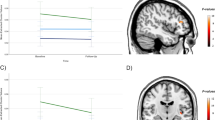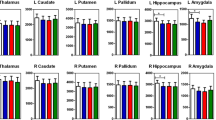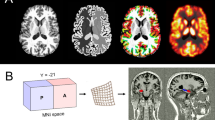Abstract
Reduced hippocampal volume has been reported in depression and may be involved in the aetiology of depressive symptoms and vulnerability to depressive relapse. Neuroplasticity following antidepressant drug treatment in the hippocampus has been demonstrated in animal models but adaptive changes after such treatment have not been shown in humans. In this study, we determined whether grey matter loss in the hippocampus in depression (1) is present in medication-free depressed (2) changes in response to antidepressant treatment and (3) is present as a stable trait in medication-free remitted patients. Sixty-four medication-free unipolar depressed patients: 39 currently depressed and 25 in remission, and 66 healthy controls (HC) underwent structural magnetic resonance imaging in a cross-sectional and longitudinal design. Thirty-two currently depressed participants were then treated with the antidepressant citalopram for 8 weeks. Adherence to treatment was evaluated by measuring plasma citalopram concentration. We measured regional variation in grey matter concentration by using voxel-based morphometry-Diffeomorphic Anatomical Registration Through Exponentiated Lie algebra. Patients with current depression had bilaterally reduced grey matter in the hippocampus compared with HC and untreated patients in stable remission with the latter groups not differing. An increase in grey matter was observed in the hippocampus following treatment with citalopram in currently depressed patients. Grey matter reduction in the hippocampus appears specific to the depressed state and is a potential biomarker for a depressive episode.
This is a preview of subscription content, access via your institution
Access options
Subscribe to this journal
Receive 12 print issues and online access
$259.00 per year
only $21.58 per issue
Buy this article
- Purchase on Springer Link
- Instant access to full article PDF
Prices may be subject to local taxes which are calculated during checkout



Similar content being viewed by others
References
Price JL, Drevets WC . Neurocircuitry of mood disorders. Neuropsychopharmacology 2011; 35: 192–216.
Arnone D, McIntosh AM, Ebmeier KP, Munafo MR, Anderson IM . Magnetic resonance imaging studies in unipolar depression: systematic review and meta-regression analyses. Eur Neuropsychopharmacol 2011; 22: 1–16.
Kempton MJ, Salvador Z, Munafo MR, Geddes JR, Simmons A, Frangou S et al. Structural neuroimaging studies in major depressive disorder. Meta-analysis and comparison with bipolar disorder. Arch Gen Psychiatry 2011; 68: 675–690.
Bora E, Fornito A, Pantelis C, Yucel M . Gray matter abnormalities in major depressive disorder: a meta-analysis of voxel based morphometry studies. J Affect Disord 2011; 138: 9–18.
Tang Y, Wang F, Xie G, Liu J, Li L, Su L et al. Reduced ventral anterior cingulate and amygdala volumes in medication-naive females with major depressive disorder: a voxel-based morphometric magnetic resonance imaging study. Psychiat Res 2007; 156: 83–86.
Vasic N, Walter H, Hose A, Wolf RC . Gray matter reduction associated with psychopathology and cognitive dysfunction in unipolar depression: a voxel-based morphometry study. J Affect Disord 2008; 109: 107–116.
Frodl T, Koutsouleris N, Bottlender R, Born C, Jager M, Morgenthaler M et al. Reduced gray matter brain volumes are associated with variants of the serotonin transporter gene in major depression. Mol Psychiatry 2008; 13: 1093–1101.
Wagner G, Koch K, Schachtzabel C, Schultz CC, Sauer H, Schlosser RG . Structural brain alterations in patients with major depressive disorder and high risk for suicide: evidence for a distinct neurobiological entity? NeuroImage 2011; 54: 1607–1614.
Zou K, Deng W, Li T, Zhang B, Jiang L, Huang C et al. Changes of brain morphometry in first-episode, drug-naive, non-late-life adult patients with major depression: an optimized voxel-based morphometry study. Biol Psychiatry 2009; 67: 186–188.
Reagan LP, McEwen BS . Controversies surrounding glucocorticoid-mediated cell death in the hippocampus. J Chem Neuroanat 1997; 13: 149–167.
Cameron HA, Tanapat P, Gould E . Adrenal steroids and N-methyl-D-aspartate receptor activation regulate neurogenesis in the dentate gyrus of adult rats through a common pathway. Neuroscience 1998; 82: 349–354.
Rajkowska G . Postmortem studies in mood disorders indicate altered numbers of neurons and glial cells. Biol Psychiatry 2000; 48: 766–777.
Scheuerecker J, Meisenzahl EM, Koutsouleris N, Roesner M, Schopf V, Linn J et al. Orbitofrontal volume reductions during emotion recognition in patients with major depression. J Psychiatry Neurosci 2010; 35: 311–320.
Chen CH, Ridler K, Suckling J, Williams S, Fu CH, Merlo-Pich E et al. Brain imaging correlates of depressive symptom severity and predictors of symptom improvement after antidepressant treatment. Biol Psychiatry 2007; 62: 407–414.
Salvadore G, Nugent AC, Lemaitre H, Luckenbaugh DA, Tinsley R, Cannon DM et al. Prefrontal cortical abnormalities in currently depressed versus currently remitted patients with major depressive disorder. NeuroImage 2010; 54: 2643–2651.
Cheng YQ, Xu J, Chai P, Li HJ, Luo CR, Yang T et al. Brain volume alteration and the correlations with the clinical characteristics in drug-naive first-episode MDD patients: a voxel-based morphometry study. Neurosci Lett 2010; 480: 30–34.
Lai CH, Hsu YY . A subtle grey-matter increase in first-episode, drug-naive major depressive disorder with panic disorder after 6 weeks' duloxetine therapy. Int J Neuropsychopharmacol 2011; 14: 225–235.
Duman RS, Monteggia LM . A neurotrophic model for stress-related mood disorders. Biol Psychiatry 2006; 59: 1116–1127.
Malberg JE, Eisch AJ, Nestler EJ, Duman RS . Chronic antidepressant treatment increases neurogenesis in adult rat hippocampus. J Neurosci 2000; 20: 9104–9110.
Perera TD, Lisanby SH . Neurogenesis and depression. J Psychiatr Pract 2000; 6: 322–333.
Duman RS . Depression: a case of neuronal life and death? Biol Psychiatry 2004; 56: 140–145.
Lavretsky H, Roybal DJ, Ballmaier M, Toga AW, Kumar A . Antidepressant exposure may protect against decrement in frontal gray matter volumes in geriatric depression. J Clin Psychiatry 2005; 66: 964–967.
Campbell S, Macqueen G . The role of the hippocampus in the pathophysiology of major depression. J Psychiatry Neurosci 2004; 29: 417–426.
Frodl TS, Koutsouleris N, Bottlender R, Born C, Jager M, Scupin I et al. Depression-related variation in brain morphology over 3 years: effects of stress? Arch Gen Psychiatry 2008; 65: 1156–1165.
Ashburner J, Friston KJ . Voxel-based morphometry—the methods. NeuroImage 2000; 11 (6 Pt 1): 805–821.
First MB, Spitzer RL, Gibbon M, Williams JBW . Structural Clinical Interview for DSM-IV-TR Axis I Disorders, Reserach Version, Non-Patient Edition. (SCID-I/NP). Department of Biometric Research, New York State Psychiatric Institute: New York:, 2002.
Montgomery SA, Asberg M . A new depression scale designed to be sensitive to change. Br J Psychiatry 1979; 134: 382–389.
Hamilton M . The assessment of anxiety states by rating. Br J Med Psychol 1959; 32: 50–55.
Ammons RB, Ammons CH . The Quick Test (QT) - Provisional Manual. Psychol Rep 1962; 11: 111–161.
WMA. Declaration of Helsinki: Ethical Principles for Medical Research Involving Human Subjects World Medical Association 2000; http://www.wma.net/en/30publications/10policies/b3/index.html.
Ashburner J . A fast diffeomorphic image registration algorithm. NeuroImage 2007; 38: 95–113.
Ridgway GR, Omar R, Ourselin S, Hill DL, Warren JD, Fox NC . Issues with threshold masking in voxel-based morphometry of atrophied brains. NeuroImage 2009; 44: 99–111.
Easy Volume L. Easy Volume. (cited; available from: http://www.sbirc.ed.ac.uk/LCL/LCL_M1.html).
Hayasaka S, Phan KL, Liberzon I, Worsley KJ, Nichols TE . Nonstationary cluster-size inference with random field and permutation methods. NeuroImage 2004; 22: 676–687.
Inkster B, Rao AW, Ridler K, Nichols TE, Saemann PG, Auer DP et al. Structural brain changes in patients with recurrent major depressive disorder presenting with anxiety symptoms. J Neuroimaging 2010; 21: 375–382.
Tzourio-Mazoyer N, Landeau B, Papathanassiou D, Crivello F, Etard O, Delcroix N et al. Automated anatomical labeling of activations in SPM using a macroscopic anatomical parcellation of the MNI MRI single-subject brain. Neuroimage 2002; 15: 273–289.
Maldjian JA, Laurienti PJ, Kraft RA, Burdette JH . An automated method for neuroanatomic and cytoarchitectonic atlas-based interrogation of fMRI data sets. Neuroimage 2003; 19: 1233–1239.
Maldjian JA, Laurienti PJ, Burdette JH . Precentral gyrus discrepancy in electronic versions of the Talairach atlas. Neuroimage 2004; 21: 450–455.
Maldjian JA, Laurienti PJ, Burdette JH, Kraft RA . Clinical implementation of spin-tag perfusion magnetic resonance imaging. J Comput Assist Tomogr 2008; 32: 403–406.
Nordanskog P, Dahlstrand U, Larsson MR, Larsson EM, Knutsson L, Johanson A . Increase in hippocampal volume after electroconvulsive therapy in patients with depression: a volumetric magnetic resonance imaging study. J ECT 2010; 26: 62–67.
Lai CH, Hsu YY, Wu YT . First episode drug-naive major depressive disorder with panic disorder: gray matter deficits in limbic and default network structures. Eur Neuropsychopharmacol 2010; 20: 676–682.
MacQueen GM, Ramakrishnan K, Ratnasingan R, Chen B, Young LT . Desipramine treatment reduces the long-term behavioural and neurochemical sequelae of early-life maternal separation. Inte J Neuropsychopharmacol 2003; 6: 391–396.
Young LT, Bakish D, Beaulieu S . The neurobiology of treatment response to antidepressants and mood stabilizing medications. J Psychiatry Neurosci 2002; 27: 260–265.
Stewart RJ, Chen B, Dowlatshahi D, MacQueen GM, Young LT . Abnormalities in the cAMP signaling pathway in post-mortem brain tissue from the Stanley Neuropathology Consortium. Brain Res Bull 2001; 55: 625–629.
Dowlatshahi D, MacQueen GM, Wang JF, Young LT . Increased temporal cortex CREB concentrations and antidepressant treatment in major depression. Lancet 1998; 352: 1754–1755.
Aydemir O, Deveci A, Taneli F . The effect of chronic antidepressant treatment on serum brain-derived neurotrophic factor levels in depressed patients: a preliminary study. Prog Neuro-Psych Biol Psych 2005; 29: 261–265.
Schermuly I, Wolf D, Lieb K, Stoeter P, Fellgiebel A . State dependent posterior hippocampal volume increases in patients with major depressive disorder. J Affect Disord 2011; 135: 405–409.
Sheline YI, Gado MH, Kraemer HC . Untreated depression and hippocampal volume loss. Am J Psychiatry 2003; 160: 1516–1518.
Arnone D, McKie S, Elliott R, Thomas EJ, Downey D, Juhasz G et al. Increased amygdala responses to sad but not fearful faces in major depression: relation to mood state and pharmacological treatment. Am J Psychiatry 2012; 169: 841–850.
Montag C, Basten U, Stelzel C, Fiebach CJ, Reuter M . The BDNF Val66Met polymorphism and anxiety: support for animal knock-in studies from a genetic association study in humans. Psychiat Res 2010; 179: 86–90.
Juhasz G, Dunham JS, McKie S, Thomas E, Downey D, Chase D et al. The CREB1-BDNF-NTRK2 pathway in depression: multiple gene-cognition-environment interactions. Biol Psychiatry 2011; 69: 762–771.
Phillips ML, Drevets WC, Rauch SL, Lane R . Neurobiology of emotion perception II: implications for major psychiatric disorders. Biol Psychiatry 2003; 54: 515–528.
Bell-McGinty S, Butters MA, Meltzer CC, Greer PJ, Reynolds CF, Becker JT . Brain morphometric abnormalities in geriatric depression: long-term neurobiological effects of illness duration. Am J Psychiatry 2002; 159: 1424–1427.
Kim MJ, Hamilton JP, Gotlib IH . Reduced caudate gray matter volume in women with major depressive disorder. Psychiat Res 2008; 164: 114–122.
Abe O, Yamasue H, Kasai K, Yamada H, Aoki S, Inoue H et al. Voxel-based analyses of gray/white matter volume and diffusion tensor data in major depression. Psychiat Res 2010; 181: 64–70.
Bergouignan L, Chupin M, Czechowska Y, Kinkingnehun S, Lemogne C, Le Bastard G et al. Can voxel based morphometry, manual segmentation and automated segmentation equally detect hippocampal volume differences in acute depression? NeuroImage 2009; 45: 29–37.
Mak AK, Wong MM, Han SH, Lee TM . Gray matter reduction associated with emotion regulation in female outpatients with major depressive disorder: a voxel-based morphometry study. Prog Neuro-Psych Biol Psych 2009; 33: 1184–1190.
Peng J, Liu J, Nie B, Li Y, Shan B, Wang G et al. Cerebral and cerebellar gray matter reduction in first-episode patients with major depressive disorder: a voxel-based morphometry study. Eur J Radiol 2010; 80: 395–399.
Shah PJ, Ebmeier KP, Glabus MF, Goodwin GM . Cortical grey matter reductions associated with treatment-resistant chronic unipolar depression. Controlled magnetic resonance imaging study. Br J Psychiatry 1998; 172: 527–532.
Li CT, Lin CP, Chou KH, Chen IY, Hsieh JC, Wu CL et al. Structural and cognitive deficits in remitting and non-remitting recurrent depression: a voxel-based morphometric study. NeuroImage 2010; 50: 347–356.
van Tol MJ, van der Wee NJ, van den Heuvel OA, Nielen MM, Demenescu LR, Aleman A et al. Regional brain volume in depression and anxiety disorders. Arch Gen Psychiatry 2010; 67: 1002–1011.
Gerritsen L, Comijs HC, van der Graaf Y, Knoops AJ, Penninx BW, Geerlings MI . Depression, hypothalamic pituitary adrenal axis, and hippocampal and entorhinal cortex volumes—the SMART Medea study. Biol Psychiatry 2011; 70: 373–380.
Surget A, Tanti A, Leonardo ED, Laugeray A, Rainer Q, Touma C et al. Antidepressants recruit new neurons to improve stress response regulation. Mol Psychiatry 2011; 16: 1177–1188.
Chen MC, Hamilton JP, Gotlib IH . Decreased hippocampal volume in healthy girls at risk of depression. Arch Gen Psychiatry 2010; 67: 270–276.
Voormolen EH, Wei C, Chow EW, Bassett AS, Mikulis DJ, Crawley AP . Voxel-based morphometry and automated lobar volumetry: the trade-off between spatial scale and statistical correction. NeuroImage 2010; 49: 587–596.
Mevel K, Desgranges B, Baron JC, Landeau B, de La Sayette V, Viader F et al. Which SPM method should be used to extract hippocampal measures in early Alzheimer's disease? J Neuroimaging 2011; 21: 310–316.
Groves JO . Is it time to reassess the BDNF hypothesis of depression? Mol Psychiatry 2007; 12: 1079–1088.
Obergriesser T, Ende G, Braus DF, Henn FA . Long-term follow-up of magnetic resonance-detectable choline signal changes in the hippocampus of patients treated with electroconvulsive therapy. J Clin Psychiatry 2003; 64: 775–780.
Ende G, Braus DF, Walter S, Weber-Fahr W, Henn FA . The hippocampus in patients treated with electroconvulsive therapy: a proton magnetic resonance spectroscopic imaging study. Arch Gen Psychiatry 2000; 57: 937–943.
Selvaraj S, Arnone D, Job D, Stanfield A, Farrow TF, Nugent AC et al. Grey matter differences in bipolar disorder: a meta-analysis of voxel-based morphometry studies. Bipolar Disord 2012; 14: 135–145.
Arnone D, Cavanagh J, Gerber D, Lawrie SM, Ebmeier KP, McIntosh AM . Magnetic resonance imaging studies in bipolar disorder and schizophrenia: meta-analysis. Br J Psychiatry 2009; 195: 194–201.
Acknowledgements
We thank all the participants, without their interest in our research this study would not have been possible. We are grateful to the Manchester Wellcome Trust Clinical Research Facility for help in recruiting, screening and scanning of volunteers, to staff at the Neuroscience and Psychiatry Unit (Dr Diana Chase, Kathryn Lloyd-Williams, Dr Karen Lythe, Dr Ivan Koychev and Christine Holliday) and to the Mental Health Research Network (MHRN, Moira Winters, Isabel Adeyemi, Vicky Bell, Humera Hussain and Martina Witter) for their assistance in recruitment and data acquisition. Prof. Anderson had full access to all of the data in the study and takes responsibility for the integrity of the data and the accuracy of the data analysis. This study was funded by the NEWMOOD EU Integrated Programme LSHM-CT-2004-503474 and the Medical Research Council UK (REMEDi) G0601526. The NIHR Manchester Biomedical Research Centre provided additional financial support and the REMEDi study was adopted as a portfolio study by the UK Clinical Research Network (UKCRN).
Author information
Authors and Affiliations
Corresponding author
Ethics declarations
Competing interests
Prof. Deakin has carried out consultancy and speaking engagements for Bristol Myers Squibb, AstraZeneca, Eli Lilly, Schering Plough, Janssen-Cilag and Servier. All fees are paid to the University of Manchester to reimburse them for the time taken. He has share options in P1vital. Prof. Anderson has received grant support from AstraZeneca and Servier; consultancy fees/honoraria for speaking/support to attend conferences from Wyeth, Servier, Eli Lilly and Lundbeck; Prof Williams receives grant funding from AstraZeneca and has had research grant support from Pfizer and Servier in recent years. Dr Elliott has received consultancy fees from Cambridge Cognition. Dr Arnone has received travel grants from Servier and Jannsen-Cilag. The remaining authors declare no conflict of interest.
Additional information
Supplementary Information accompanies the paper on the Molecular Psychiatry website
Rights and permissions
About this article
Cite this article
Arnone, D., McKie, S., Elliott, R. et al. State-dependent changes in hippocampal grey matter in depression. Mol Psychiatry 18, 1265–1272 (2013). https://doi.org/10.1038/mp.2012.150
Received:
Revised:
Accepted:
Published:
Issue Date:
DOI: https://doi.org/10.1038/mp.2012.150
Keywords
This article is cited by
-
A transdiagnostic network for psychiatric illness derived from atrophy and lesions
Nature Human Behaviour (2023)
-
Relationship between childhood maltreatment and cognitive function in medication-free patients with major depressive disorder
European Archives of Psychiatry and Clinical Neuroscience (2023)
-
AI-based dimensional neuroimaging system for characterizing heterogeneity in brain structure and function in major depressive disorder: COORDINATE-MDD consortium design and rationale
BMC Psychiatry (2023)
-
Pathological fear, anxiety and negative affect exhibit distinct neurostructural signatures: evidence from psychiatric neuroimaging meta-analysis
Translational Psychiatry (2022)
-
Morphometry of the Hippocampus Across the Adult Life-Span in Patients with Depressive Disorders: Association with Neuroticism
Brain Topography (2021)



